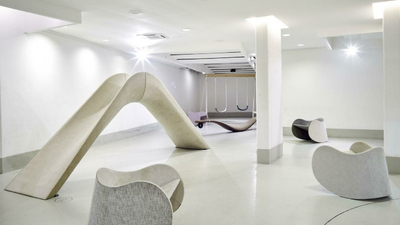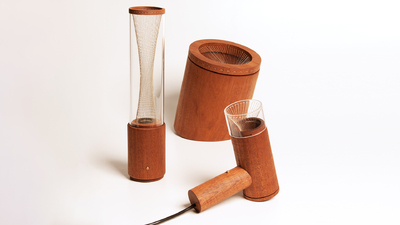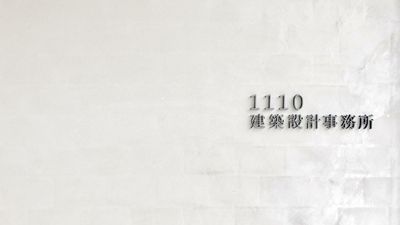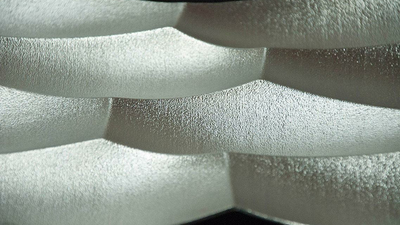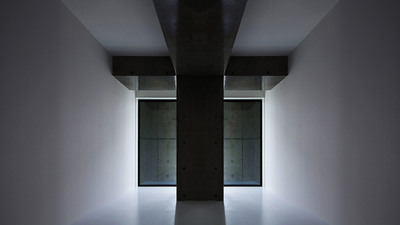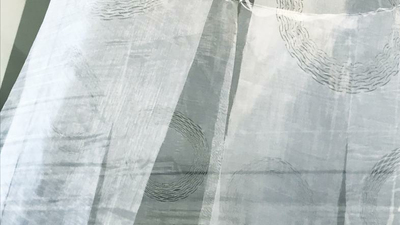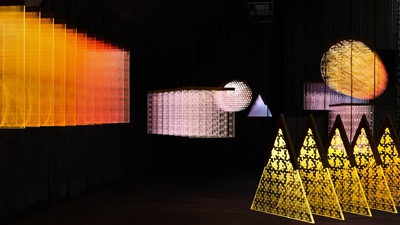transient matter
9+1 is a creative collective based in Japan, which goal is to create future possibilities for traditional crafts. For this installation, in collaboration with craftsmen in the region of Takaoka in Japan, we explored the different aspects of Urushi, a traditional material widely used in craft making in Japan.
Our team of creators are diverse in discipline. Starting from the local craftsman in Takaoka city, graphic designers, product designers, creative planners and engineers are among the 9+1 team.
CRAFTSCAPE
Designer : Youichi Sakamoto
Craftsman : Takaaki Yamamura
Traditionally, the reflective surface of the Urushi lacquer is described with the metaphor of water surface. This art piece brings this metaphor alive by shining a LED light on a reflective surface made of Urushi. By laser cutting a normally rigid Urushi, we created a flexible surface which is moved by motors. When the reflected light is shone on a wall, the contrast with the shadow brings life to a constantly changing landscape of light.
Link
CRAFTSCAPE 2
Designer : Youichi Sakamoto
Craftsman : Takaaki Yamamura
By painting Urushi, a type of lacquer, any rough texture of the wood metamorphoses into an abstract and highly reflective black smooth surface. This installation uses a spherical object coated with Urushi as a reflective surface for the light. The light source moves like a pendulum and creates images of a distorted space with time. The reflection is dynamic; a rectangle at one point, it changes into a spherical shape like that of the moon in the next moment.
Link
CRAFTPRISM
Designer : Yuko Sakamoto
Craftsman : Takaaki Yamamura
Urushi lacquer was used as a adhesive material. This led to Kintsugi, a technique which consists of repairing a broken object by using the Urushi as adhesive and outlining the line of fracture with gold powder. Kintsugi is more than a way of repairing an object and has a philosophical meaning to it.
In this art piece, a lense was cut into small pieces and put back again using the kintsugi technique to recreate the view. The Urushi is used to merge the pieces in a physical way as well as to recreate the landscape of the view.
Link
CRAFTEXTILE
Tailor : Taichiro Takamamatsu
The textile is made of a combination of silk and conductive copper thread, and colored using a traditional copper patinas coloring technique. Many color and texture can be created such as “Niiro”, “Dou-cho shoku”, “Syu-dou shoku”, “Ohauro”, “Yakiseidou”, “Mitsurou”, each of them being used as a traditional way of coloring flower pots and tea sets. This new type of textile allows us to apply the deep history of copper patinas coloring to textile.
Link
CRAFTMOVE
Designer : Nanami Nakamura
Craftsman : Takaaki Yamamura
Chyokoku-nuri is traditional Japanese craft technique which consist of applying Urushi lacquer on a sculpted wood. The smooth color of the Urushi emphasizes the beauty of the sculpted form, to result in a new artistic expression.
The deep black Urushi is traditionally made by mixing iron oxide with lacquer.
Because of the magnetic property of the iron oxide, the sculpted form has is own magnetic pattern. In this installation piece, we visualized this magnetic pattern that the craft has using magnetic sheets.
Link
CRAFTCIRCUIT
Designer : Youichi Sakamoto
Electronic circuits have an aesthetic which come from their functionality. Similarly, the simple aesthetic of traditional crafts also result from the making process and its function. In this product, we used the traditional material Urushi lacquer as an insulator and the gold leaf as a conductor to create an electronic circuit. The combination of these material works as a sensor for water lighting up a LED. The information about the water inside of the bowl is transferred into a digital information. This piece suggests a new possibility of combining digital technology with that of the traditional craft industry.
Link


















